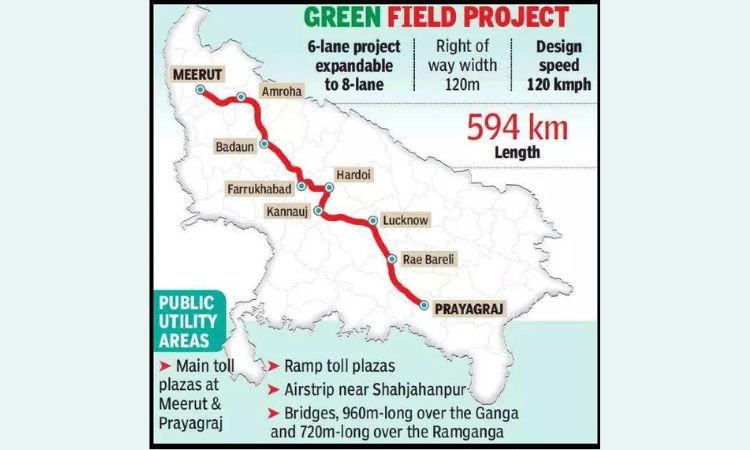Ganga Expressway: Cost, Route Map, Completion Date & More
The Ganga Expressway is a massive infrastructure project in Uttar Pradesh, India, that aims to increase connectivity and economic development. This expressway is approximately 594 kilometers long; it will link Meerut in western Uttar Pradesh to Prayagraj in the east—the longest expressway in India.
It will pass through 12 districts-major cities such as Meerut, Hapur, Amroha, Bulandshahr, and Prayagraj-covering critical economic and industrial zones. Ganga Expressway is a six-lane road, and it will be extended to eight-lane in the future.
The major impact of this ambitious project is that it will reduce travel time between Meerut and Prayagraj and enhance connectivity and development. It will take less than 8 hours to complete the journey.
This is an initiative by the Uttar Pradesh Expressways Industrial Development Authority (UPEIDA) with the plan to enhance regional trade and tourism besides offering a smoother link between the two parts of the state. It is also expected to help in strengthening the agriculture sectors in the state.
The estimated cost of the Ganga Expressway is approximately ₹36,230 crores. This project is set to play an important role in making the state socio-economically effective, increasing industrial growth, and developing new employment opportunities in the entire state.
Also Read – Delhi Mumbai Expressway
Ganga Expressway Contractors List
The construction work of the Ganga Expressway has been divided into 12 packages awaited, including the prime contractor.
IRB Infrastructure:
IRB Infrastructure is responsible for 1 to 4 packages to be constructed and maintained.
First Package: Route: Bijamulu (Meerut) to Chandner (Hapur)
Length Around: 48.8km
Second Package: Route: Chandan (Hapur)-Mirzapur Dujal (Amroha)
Length Around: 30.0 km
Package Third: Route: Mirzapur Dungal (Amroha)-Nagla Barha (Buraun)
Length Around: 50.7km
Package Fourth: Route: Nagla Baraha (Budaun)-Binawar (Budaun)
Length Around: 52.1km.
Adani Enterprises:
Adani Enterprises is responsible for 5 up to 12 packages to be constructed and maintained.
The Ganga Expressway is India’s second-largest expressway and connects eastern and western Uttar Pradesh. It reduces travel time between Delhi and Paryagraj by half.
Package Fifth: Route: Binawar (Budaun)–Dari Gulau (Shahjahanpur)
Length Around: 46.7km
Package Sixth: Route: Dari Gulau (Shahjahanpur)-Ubariya Khurd (Hardoi)
Length Around: 52.9km
Package Seventh: Route: Ubariya Khurd (Hardoi)-Kisai (Hardoi)
Length Around: 52.4km
Package Eighth: Route—Kisai (Hardoi)—Raiya Mao (Unnao)
Length Around: 50.2km
Package Ninth: Route – Raiya Mao (Unnao) – Difference Village (Unnao)
Length Around: 53.1km
Package Tenth: Route: Sarson (Unnao)-Terukha (Rae Bareli)
Length Around: 51.8km
Package Eleventh: Route: Terukha (Rae Bareli)-Naudhiya (Pratapgarh)
Length Around: 52.0 km
Package Twelfth: Route: Naudhiya (Pratapgarh)–Judpur Dandu (Prayagraj)
Length Around: 53.0 km.
Also Read – Best Two Colour Combination for bedroom Walls
Ganga Expressway History
The Ganga Expressway project has a history drenched in the vision of Uttar Pradesh to uplift its road infrastructure and regional connectivity.
The idea for the expressway first took shape way back in 2007 when then Chief Minister Mayawati came up with a big plan to lift connectivity across Uttar Pradesh.
The original proposal was to develop a vast expressway on one side of the Ganga River, spanning between Greater Noida and Ballia, which aims to reduce crossing time over the state’s eastern and western parts, thereby supporting socio-economic development.
The project, however, involved multiple clearances pertaining to environmental and development issues, because of which the project could not see the light of day in 2010.
Also, opposition from environmentalists over issues regarding the river’s ecosystem and farming lands furthered the delay of the project.
The project was restarted in 2019 by Chief Minister Yogi Adityanath. Though the route remained the same as in the earlier plan, this was shifted to the Meerut to Prayagraj expressway, which is over 594 kilometers long and bypassed the controversies that had gathered dust over environmental issues.
The state government fast-tracked the acquisition of land first and started construction work subsequently after their clearance processes were cleared.
The expressway is under development and is set to be completed by 2025, making it one of the major strides in the infrastructure advancement of Uttar Pradesh.
Also Read – TOP 10 Biggest City in India
Key Features of Ganga Expressway
- The Expressway is under construction, and the length is 594 KM with six lanes expandable to eight in the future.
- The Ganga Expressway is a greenfield project, which means it’s being constructed on a new land area rather than an old one.
- The major cities to be connected are Meerut, Hapur, Bulandshahr, Budaun, Sambhal, Shahjahanpur, Bilgram, Hardoi, Madhoganj, Mallawan, Safipur, Unnao, Pratapgarh, Prayagraj, and more.
- The foundation stone was laid by PM Narendra Modi on 18 December 2021, and the expressway is expected to be operational by December 2024.
- The project is maintained by the Uttar Pradesh Expressways Industrial Development Authority (UPEIDA), and the project model is design-build-finance-operate-transfer.
- The budget of the Ganga Expressway is Rs. 37,350 crore, including land acquisition costs of around 9,500 crore.
- The expressway includes several bridges and toll plazas, including two major bridges over the Ganga and Ramganga rivers, and the speed limit is 120 km/h.
Ganga Expressway Route Map

The Ganga Expressway will span approximately 594 kilometers, connecting Meerut in western Uttar Pradesh to Prayagraj in the east.
The route map of the Ganga Expressway passes through 12 districts, strategically connecting various economic hubs and reducing travel time across the state. Here is an overview of the major stops along the route:
Here’s a step-by-step breakdown of the Ganga Expressway’s route:
- Starting Point: Meerut—The expressway begins in Meerut, connecting it to other major cities in the western part of Uttar Pradesh.
- Hapur: The expressway moves southeast to Hapur, enhancing connectivity for industrial zones.
- Amroha: From Hapur, it continues towards Amroha, providing better transportation links for local trade.
- Sambhal: Next, the route passes through Sambhal, helping improve accessibility in this relatively less developed area.
- Badaun: The expressway then crosses through Badaun, known for its agricultural significance.
- Shahjahanpur: Continuing onward, it reaches Shahjahanpur, a key stop for agriculture and industry in Uttar Pradesh.
- Farrukhabad: The route moves towards Farrukhabad, known for its historical and commercial importance.
- Hardoi: After Farrukhabad, the expressway reaches Hardoi, creating better trade opportunities for the region.
- Unnao: From Hardoi, the expressway travels to Unnao, strategically close to Kanpur, a major industrial hub.
- Rae Bareli: Moving towards central Uttar Pradesh, the expressway reaches Rae Bareli, enhancing regional connectivity.
- Pratapgarh: The next stop is Pratapgarh, known for agriculture and its proximity to Prayagraj.
- Ending Point: Prayagraj Finally, the expressway culminates in Prayagraj, a key cultural and religious city in Uttar Pradesh.
What is the Cost of Ganga Expressway?
The Ganga Expressway is under construction and being built in 4 phases. The cost of this project is estimated at around 37,350 crore.
This cost also includes the land acquisition, which is 9,500 crore, and it is expected to be completed by December 2024.
What are the Benefits of Ganga Expressway?
The Ganga Expressway in Uttar Pradesh has many benefits, including:
Improving Connectivity
Boosted Connectivity: This expressway will improve the connectivity between western Uttar Pradesh (starting in Meerut) and eastern Uttar Pradesh (ending in Prayagraj), making travel across the state smoother and faster.
Less Travel Time: With better roads, the time it takes to travel between major cities and districts will be much shorter, making road transport quicker and more efficient.
Economic Growth
The Expressway connects vital districts to improve economic growth for the infrastructure of Uttar Pradesh.
Support for local economies: The Ganga Expressway will help local economies grow by connecting important districts and making it easier to access markets, resources, and workers.
Growth of Industry: The government plans to build industrial areas along this route. Better infrastructure will also attract many investors, further strengthening local economies.
Agricultural and Rural development
Improved Market Access: Farmers and producers in rural areas will have easier access to city markets, helping them earn more money and reduce waste after harvesting.
Better Rural Infrastructure: This project will enhance road connections and support the development of services and facilities in rural areas.
Tourism Promotion
Easy Access to Tourist Attractions: The expressway makes it easier to reach different cultural, historical, and religious sites along the way, encouraging more people to visit.
Growth of Tourism Services: Improved roads help create additional tourist facilities such as hotels, restaurants, and service stations.
Ganga Expressway Toll Rate
The toll rate of the Ganga Expressway depends on the type of vehicles. Here are some expected toll charges for the Ganga Expressway.
- Cars/vans: Toll around ₹145 (one-way), ₹220 (return pass), and ₹4,905 (per monthly pass).
- Bus/truck: Toll around ₹455 (one-way), ₹685 (return pass), and ₹15,190 (per monthly pass).
- Light Commercial Vehicles (LCVs): Toll around ₹225 (one-way), ₹340 (return pass), and ₹7,535 (per monthly pass).
- Axle vehicles (more than 7 axles): Toll around ₹900 (one-way), ₹1,350 (return pass), and ₹30,005 (per monthly pass).
- Heavier vehicles (4 to 6 axles): Toll around ₹690 (one-way), ₹1,035 (return pass), and ₹23,050 (per monthly pass).
Ganga Expressway: Real Estate Impact
The project’s major impact on real estate is because of smooth connectivity and good infrastructure. This project will play an important role in the real estate sector.
It will positively affect the real estate market. Provide Better connections, infrastructure, economic growth, accessibility, and tourism will lead to higher property prices and increased demand for housing.
- Better connections and shorter travel times will lead to higher demand for homes, shops, retailers, and factories along the expressway route.
- Areas near the Ganga Expressway are likely to see major increases in land and property prices because of easier access and economic growth.
- The expressway will help create new industrial centers and logistics parks, bringing in businesses and boosting local economies.
- This project will also make it easier to reach different tourist attractions, encouraging the development of hotels, resorts, and other hospitality services.
Conclusion
In conclusion, the Ganga Expressway is one of the transformational infrastructure projects in India to improve connectivity and boost economic growth in the region.
The length of this project is approximately 600 kilometers between Meerut and Prayagraj, significantly reducing travel time and enhancing trade between the cities.
Apart from improving accessibility, the expressway also encourages regional development through investments and further accelerates industrial growth along its corridor.
It will decrease congestion on all existing routes as people will be carried to their desired destinations through this new transport network.
The Ganga Expressway is an important step towards the modernization of infrastructure in India and thus can have a healthy impact on the economy as well as numerous lives.
Read On – TOP 10 Tallest Building in India
FAQs
When Ganga Expressway will be started?
The Ganga expressway will be started in December 2024.
What is the status of the Ganga Express Highway?
Currently, this expressway is under construction, and it is expected to be completed by December 2024.
Is Ganga Expressway the longest in India?
No, the Ganga Expressway is not the longest expressway in India.
How many districts are on the Ganga Expressway?
The Ganga Expressway route covers over 12 districts of Uttar Pradesh, India.
What is the cost of the Ganga Expressway?
The Ganga Expressway cost is around 37,350 crores.
What is the speed limit of the Ganga Expressway?
The speed limit on this expressway is 120 km/hr.

